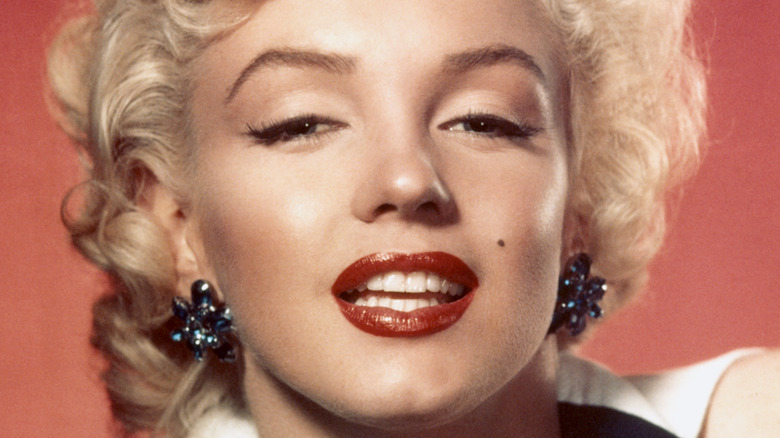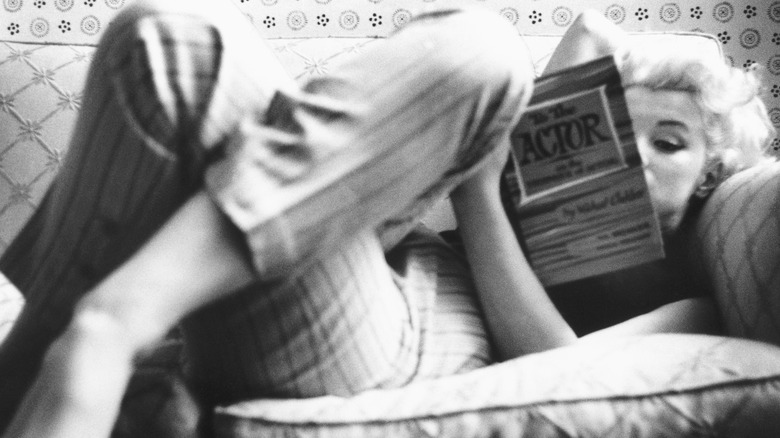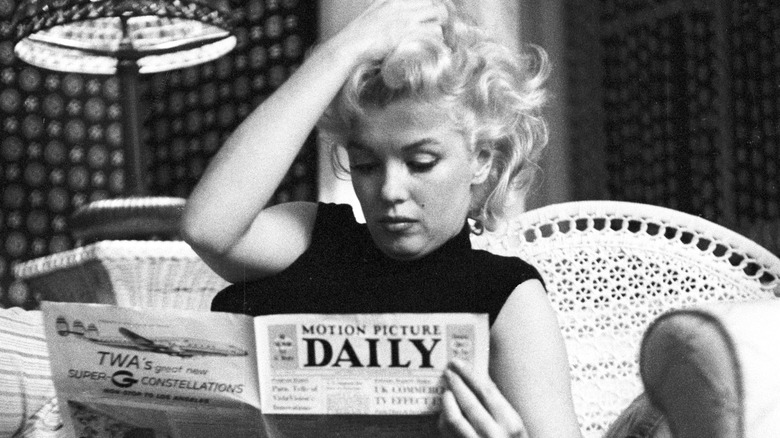Marilyn Monroe's Biggest Hobby That No One Talks About
She was many things to many people: Hollywood's it girl, a favorite actress, a sex symbol. But rarely was she recognized as an intellectual. Behind her glamorously iconic blonde hairdo and blue eyes was an incredible amount of knowledge, talent, and, sadly, pain. Born Norma Jeane Mortenson (aka Marilyn Monroe) on June 1, 1926, in Los Angeles, she was named after her mother (via History). Early in life, she was subject to trauma. Both her maternal grandparents and mother experienced mental illness and were committed to mental institutions, leaving a young Norma Jeane to be raised in foster care.
To escape foster care, she married at just 16 years old to neighbor James Dougherty, who was later sent off to serve in World War II. Monroe's beauty was eventually discovered by a photographer at the munitions factory she worked for, and that big break spiraled into a modeling career, a divorce from Dougherty, and an eventual contract with 20th Century Fox. Monroe became known not only for her beauty but also for her commanding on-screen presence in films like "The Shocking Miss Pilgrim" (1947), "The Asphalt Jungle" (1950), and "Niagara" (1953). What she was not known for, however, were her educational hobbies.
If you or someone you know is struggling with mental health, please contact the Crisis Text Line by texting HOME to 741741, call the National Alliance on Mental Illness helpline at 1-800-950-NAMI (6264), or visit the National Institute of Mental Health website.
The Academic
While a wide selection of the artifacts in The Marilyn Monroe Collection are predictable, like elegant dresses, furs and makeup, a large portion of what the starlet left behind might surprise you. Monroe had a massive library of over 400 books (via The Monroe Collection), spanning a vast array of genres and including literary greats like George Bernard Shaw, Tennessee Williams, Ernest Hemingway, F. Scott Fitzgerald, and John Steinbeck (via The Independent). She was known for loving "Ulysses" by James Joyce, and her copy sold for $9,200 in a 1999 auction. She is seen in the photo above reading Michael Chekhov's 1953 "To the Actor."
Monroe was always trying to expand her skills beyond the "dumb blonde" act she put on for Hollywood, even attending a literature course at UCLA. She withdrew shortly after in an effort to not distract the other students. She was also known to frequent museums and attend plays regularly during her time spent living in New York City, but her love for the arts did not stop there. Not only was she reading intricate books like "Man Against Himself" by Karl Menninger, "Man's Supreme Inheritance" by F. Matthias Alexander, and "Of Stars and Men" by Harlow Shapley, she was also a bit of a wordsmith as well (via The Marilyn Monroe Collection).
The Renaissance Woman
In 2012, Macmillan Publishers released "Fragments: Poems, Intimate Notes, Letters" with tidbits of writing samples spanning Marilyn Monroe's entire life until the very eve of her death in 1962 (via Macmillan Publishers). Many of the samples have never been seen before. With proof that she was so much more than what she seemed — a writer, poet, academic and avid appreciator of the arts — it's a hard reality to accept knowing that Hollywood dimmed her down to be what they wanted her to be. She has been famously quoted saying (via The Hindu), "If I play the stupid girl and ask a stupid question, I've got to follow through, what am I supposed to do, look intelligent?"
However, Monroe was hardly a victim. A true rags to riches story, she took Hollywood by storm with her beauty, and although she was far more intelligent than her work made her seem, she sadly knew the act she had to put on to stay on the throne. She once said in a 1953 interview (via Vanity Fair), "I can be smart when it's important, but most men don't like it." Monroe maximized the fictional image to its fullest potential, quickly landing powerful friends in the industry and leaving this Earth as one of the most notable names in show business.


